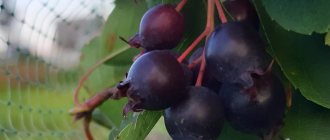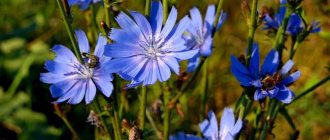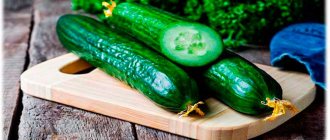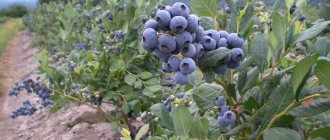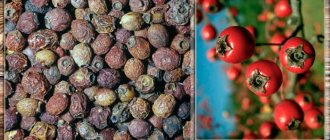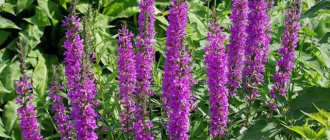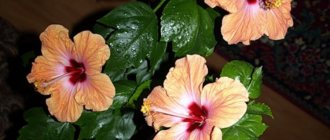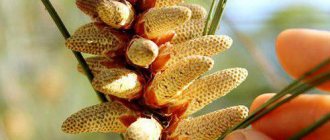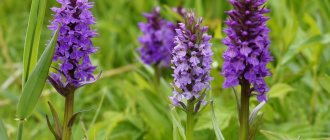Characteristics of the shrub
The goji bush is a low plant with long branches. Garden culture has the following parameters:
- Fragile shoots covered with many thin spines. The length of the branches hanging down reaches 3 m. The yellowish shrub has a gray bark of a dense structure.
- Lilac or soft pink flowers. At the moment of flowering, they fill the space around with a soft, pleasant aroma.
- Small fruits 1.5 cm long. The berries have an intense red or orange hue. The first fruits appear 2-3 years after planting the shrub in an open area.
- Berries containing nutritional components, vitamin complex, calcium, antioxidants, zinc and other biological substances. The fruits are very beneficial for the immune system.
- A crown with a diameter of up to 6 m. Considering its large size, the crop has a powerful and branched root system. Large roots do not allow the shrub to be planted on all types of soil.
- Seedlings that begin to bloom in the first month of summer. Flowering lasts until autumn. The fruits appear in several stages when the tree flowers.
The goji bush has a powerful base and several shoots with dark green, elongated and thick leaves.
Healing properties
Eastern medicine of China and Tibet endows it with truly miraculous properties. The Chinese use wolfberry in folk medicine as a general tonic. Monks believe that these berries can cure thousands of diseases. Wolfberry preparations reduce the level of lipids in the blood plasma, which confirms the anti-sclerotic effect and explains its effectiveness in fatty liver degeneration. Although women may be more interested in its anti-cellulite effect. Dereza is a powerful natural aphrodisiac. A noticeable increase in testosterone levels explains its effectiveness against impotence.
Goji is also used as a medicine for stress, diabetes, anemia, poor eyesight, and heart failure. Also taken by those who have sleep problems, high cholesterol and sugar levels. Systematic addition of berries to food helps detoxify the body from harmful substances and toxins, strengthens the cardiovascular system, and normalizes blood pressure. Add these berries to your diet and they will promote fat burning. They dull hunger.
They are used not only for the purpose of losing weight, but also as a component in the production of wines, fruit purees, desserts, soups, baked goods, yoghurts, tea, juices, and cereals. The seeds are used to produce oil. Fresh berries have a nightshade note to their taste. Frozen, dried berries have a taste similar to dried apricots.
There is a belief that berries can bestow eternal life thanks to the rich formula, which contains: 21 minerals, 18 amino acids, polysaccharides and B vitamins. There is a well-known legend when a warrior returning from a long campaign mistook his wife of the same age for an adult daughter. The wife drank tea with wolfberry, but the serving husband did not have this opportunity. According to another legend, a pilgrim returning from a Tibetan monastery, where he became addicted to wolfberry tea, married the great-granddaughter of his long-dead childhood friend. Do you want to be young? Then drink tea from wolfberry leaves.
Benefits or harms of goji berries for humans
The fruits of the common wolfberry include 15 microelements, an extensive group of vitamins, amino acids and other biologically active substances. The berries are rich in vitamin C, which has a beneficial effect on the human body.
Studies have shown that regular consumption of fruits has a positive effect on the functioning of the body as a whole. The berries of the plant are capable of:
- improve blood composition, helping in the fight against anemia;
- improve poor vision, deteriorated due to poor lifestyle;
- remove harmful toxins from the body that have accumulated over many years;
- improve the functioning of the nervous system, weakened by constant stress;
- strengthen the immune system, weakened due to lack of vitamins;
- reduce cholesterol levels and normalize liver functions disturbed by an unbalanced diet;
- improve sleep and relieve depression that accompanies modern man;
- stabilize blood pressure in hypertensive patients;
- prevent cancer.
Regular consumption of wolfberry fruits has contraindications. It is not recommended to consume berries for people suffering from allergic reactions.
Boxthorn
Dereza vulgaris or goji berries are extremely popular today. The birthplace of wolfberry is China. Solanaceae family. But not everyone knows that dereza grows here too. We know it as the common Berber wolfberry or wolfberry. This plant is versatile, as it grows not only as weeds on the side of roads, but also in the front garden as a living vegetable garden.
Dry rocky slopes, forest edges, wastelands and roadsides are the places where dereza usually grows. This long-lived deciduous shrub grows up to three meters and has delicate, cascading branches that are covered with small, sharp spines. Panicles are made from wolfberry branches for farming. The plant grows in width due to the huge number of roots. Sometimes it uses nearby growing plants as a support, thereby forming an impenetrable thicket. The elliptical-shaped leaves have a light green top and blue bottom.
Goji flowers bloom from June to September. The light purple flowers, which resemble bells, smell sweet. In early November, ruby-red, round berries appear. The sweet and sour taste is quite pleasant, reminiscent of a cocktail of cherries and cranberries. Berries, which are called health capsules, are added to their menu by adherents of a healthy diet.
The fruits grow in the second or third year.
Planting shrubs with seeds
A relatively small berry of an exotic crop contains on average 20-30 ripened seeds. You can remove them by immersing them in heated water for 3 hours. Freshly picked fruits do not need to be soaked, but it is recommended to wear gloves when handling them - the juice secreted by the berries burns the skin.
The extracted seeds are kept in a weak solution that stimulates growth. This will speed up the germination of planting material. The material is sown as follows:
- A drainage layer is placed at the bottom of a low container, which is covered with prepared loose soil mixture.
- The wolfberry seeds go 5 mm deep into the soil.
- The substrate is moistened with a spray bottle so as not to wash out the seed.
- The container is covered with transparent polyethylene and placed on a windowsill well lit by daylight.
- After approximately 7-10 days, the film is removed
- After 3 pairs of leaves appear, seedlings are picked. They are placed in separate containers - shallow cups up to 7 cm.
Goji seeds
The crop, sown in early January, is planted in open soil in the second half of May. It can be grown at home on a windowsill as a potted plant. To do this, the seedlings are planted in a large flower pot, further providing conditions appropriate for normal growth: regular watering, cool temperatures in winter and periodic replenishment of the soil.
Reproduction by cuttings
Cuttings are obtained after cutting the shoots of an adult goji bush into 10 cm long pieces. They are dipped in a solution that accelerates the formation of roots. Next, the material is planted in a greenhouse to strengthen the root system. This is usually done in August. Rooting occurs throughout the winter. In mid-spring, the strengthened plant is transplanted into open, pre-prepared soil.
Cuttings are perfectly strengthened in flower pots left on a glazed heated balcony.
At the initial stage, the culture lags far behind in development, resembling tomato seedlings in appearance. After 2-3 months, growth is activated and by 2-3 years the goji bush begins to bloom profusely.
Where and how does the common wolfberry grow in Russia?
Currently, wolfberry berries have become very popular due to their effective medicinal properties and the presence of a huge amount of microelements and vitamins.
However, they were given worldwide recognition by another, Chinese name - Goji berries .
There are many varieties of wolfberry, but some species are poisonous. Be careful!
In North America, this plant is known as Anderson's wolfberry, in China it is called Goji berries, in Chile and Argentina - Chilean wolfberry, in South Africa - African wolfberry, and in our country - common wolfberry.
Planting in open soil
Considering that under natural conditions dereza grows in mountainous areas with infertile soil, it is not picky about the composition of the soil. An exotic plant grows well in any place where other crops do not take root. The main requirement is that the area must be well lit.
14 days before planting the plants in open ground, prepare a hole up to half a meter deep. The bottom is covered with a layer of sand with a coarse fraction, on top of which there is a fertile substrate mixed with humus. You can increase the nutritional value of the soil with a mixture of 150 g of superphosphates, 30 g of potassium sulfate and 1 tbsp. wood ash. The composition is thoroughly mixed with a garden shovel. The rest of the goji planting process involves:
- Vertical placement of the shoot in the center of the prepared hole. The sprout is raised until the root collar reaches the level of the site.
- The remaining space is filled with ordinary soil.
- The soil around the seedling is compacted and watered with water heated under the sun.
- The ground around the trunk is mulched with natural fertilizer and peat.
When planting several shrubs, it is recommended to leave at least 2 m of free space between them.
Growing healthy berries from seeds
Summer residents are wondering about growing goji from seeds. This is because plant seedlings are expensive. Seeds from which you can grow healthy seedlings are sold on the Internet and in specialized nurseries.
In order to save money, people practice purchasing dry fruits of the plant at the market. In this case, there is a high risk of being left without a harvest, since it is impossible to predict what the seedling will turn out to be. There is no guarantee that it will be able to gain strength in a warm-temperate climate.
If the purchased seeds are grafted, then sowing is simple:
- A box with a mixture for growing seedlings (nutrient substrate) is prepared.
- The surface of the earth is moistened. Seeds are planted at the base. No pre-treatment is required.
- The seeds are sprinkled with a soil layer of no more than 3 centimeters.
- The box with plantings is placed in a lighted room.
- The surface of the earth is sprayed daily for 15 days.
- On the 16th-17th day, young seedlings will emerge from the ground.
- When the plants reach 7 centimeter shoots, they can be planted in garden beds.
After the seedling's cotyledon opens, the plant must be treated with phytosporin. The event will protect crops from attack by fungal infections. Subsequent growth is accompanied by fertilizing with mineral fertilizers with a predominance of potassium humate.
Features of proper crop care
When grown at home, the goji bush is unpretentious in care and feels great without constant human intervention. It does not require abundant watering even in dry weather. It is enough to water the crop once every 7 days.
It is advisable to feed exotic shrubs during the growing season. Otherwise, the plant grows normally without fertilizing thanks to its powerful root system, which easily takes root in infertile soil.
The shrub tolerates pruning well. New shoots are actively appearing at the site where the branch is cut. The crown can be given any shape, as in ornamental gardening.
The plant does not tolerate extremely low temperatures, under the influence of which it can die. Gardeners recommend covering the bush for the winter. To do this, use plastic film or spruce branches. This allows you to create a suitable microclimate and saves goji from frost. In climate zones with harsh winters, the exotic crop is transplanted into a large container and left to overwinter in a warm place.
Prevention of diseases and pests
A distinctive feature of wolfberry is its frost resistance and resistance to diseases and pests.
Goji plant can be treated from time to time for prevention. It is also necessary to regularly inspect the bush for traces of pests.
If any, the affected leaves are removed and burned. You can spray the plant with special preparations against pests or use folk remedies.
One of the diseases that affects the plant is powdery mildew. It appears from a lack of ash, which must be added to the hole when planting.
Collection of ripe fruits
The fruits of the Common wolfberry appear in the third year after growing in open soil. They fill the branches thickly. Small, elongated berries with deep red or orange hues have a sweet taste with a pleasant bitterness. They ripen throughout the summer, so their collection takes place in several stages.
During active fruiting, up to 12 harvests are harvested. One mature bush produces 7-10 kg of berries. For long-term storage, the fruits are dried at a temperature of +50 °C. Dried goji, which tastes like raisins, is placed in a glass or ceramic container with a hermetically sealed lid.
Chinese dereza is an exotic shrub that grows well in different latitudes. With proper planting and proper care, you can get an impressive harvest of sweet fruits that will saturate the body with the missing vitamins and microelements in winter.
Which parts of the plant should you use?
1. Goji berries are usually used in dried form. You should not pick berries with your bare hands, as fresh juice from wolfberries can irritate your skin (much like the juice from fresh pineapple). It’s better to spread a cloth under the bush and knock the berries off the branches. The fruits should be harvested when they turn bright red and have reached full ripeness. Unripe fresh berries can cause poisoning. No wonder one of their names is wolfberry.
First you need to dry the berries, then separate them from the stalk. In order for the raw materials to acquire medicinal properties, the berries must be dried until the skin peels off. Drying can only be done naturally, without the use of ovens or preservatives.
2. Goji root bark - used for coughs, fever, lowers blood cholesterol, and is also used as a diuretic and laxative. To obtain raw materials, you need to dig up the roots, wash them, remove the bark and dry them thoroughly in the sun. Then make decoctions from the bark.
3. Invigorating teas are made from goji leaves
Keep in mind that the Russian body, unlike the Chinese or Tibetans, is not characterized by a large consumption of goji berries. Our body is not able to immediately adapt to high consumption of fruits and other parts of this plant. In this regard, those who are heavily addicted to wolfberry may experience kidney problems and severe dehydration.
